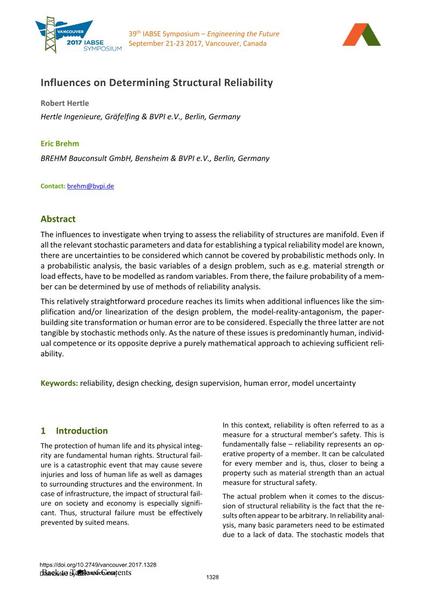Influences on Determining Structural Reliability

|
|
|||||||||||
Détails bibliographiques
| Auteur(s): |
Robert Hertle
(Hertle Ingenieure, Gräfelfing & BVPI e.V., Berlin, Germany)
Eric Brehm (BREHM Bauconsult GmbH, Bensheim & BVPI e.V., Berlin, Germany) |
||||
|---|---|---|---|---|---|
| Médium: | papier de conférence | ||||
| Langue(s): | anglais | ||||
| Conférence: | IABSE Symposium: Engineering the Future, Vancouver, Canada, 21-23 September 2017 | ||||
| Publié dans: | IABSE Symposium Vancouver 2017 | ||||
|
|||||
| Page(s): | 1328-1335 | ||||
| Nombre total de pages (du PDF): | 8 | ||||
| Année: | 2017 | ||||
| DOI: | 10.2749/vancouver.2017.1328 | ||||
| Abstrait: |
The influences to investigate when trying to assess the reliability of structures are manifold. Even if all the relevant stochastic parameters and data for establishing a typical reliability model are known, there are uncertainties to be considered which cannot be covered by probabilistic methods only. In a probabilistic analysis, the basic variables of a design problem, such as e.g. material strength or load effects, have to be modelled as random variables. From there, the failure probability of a mem- ber can be determined by use of methods of reliability analysis. This relatively straightforward procedure reaches its limits when additional influences like the sim- plification and/or linearization of the design problem, the model-reality-antagonism, the paper- building site transformation or human error are to be considered. Especially the three latter are not tangible by stochastic methods only. As the nature of these issues is predominantly human, individ- ual competence or its opposite deprive a purely mathematical approach to achieving sufficient reli- ability. |
||||
